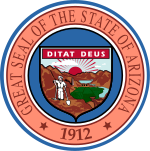| ||||||||||||||||||||||||||
All 3 Arizona votes to the Electoral College | ||||||||||||||||||||||||||
|---|---|---|---|---|---|---|---|---|---|---|---|---|---|---|---|---|---|---|---|---|---|---|---|---|---|---|
| ||||||||||||||||||||||||||
 County Results
Roosevelt 50–60% 60–70% 70–80%
| ||||||||||||||||||||||||||
| ||||||||||||||||||||||||||
| Elections in Arizona |
|---|
 |
The 1940 United States presidential election in Arizona took place on November 5, 1940, as part of the 1940 United States presidential election. State voters chose three representatives, or electors, to the Electoral College, who voted for president and vice president.
Arizona was won by incumbent President Franklin D. Roosevelt (D–New York), running with U.S. Secretary of Agriculture Henry A. Wallace, with 63.49% of the popular vote, against President of Commonwealth and Southern Wendell Willkie (R–New York), running with Senate Minority Leader Charles L. McNary, with 36.01% of the popular vote.[2][3]
Results
[edit]| Party | Candidate | Votes | % | |
|---|---|---|---|---|
| Democratic | Franklin D. Roosevelt (inc.) | 95,267 | 63.49% | |
| Republican | Wendell Willkie | 54,030 | 36.01% | |
| Prohibition | Roger Babson | 742 | 0.49% | |
| Majority | 41,237 | 27.48% | ||
| Total votes | 150,039 | 100.00% | ||
Results by county
[edit]| County[4] | Franklin Delano Roosevelt Democratic |
Wendell Lewis Willkie Republican |
Roger Ward Babson Prohibition |
Margin | Total votes cast | ||||
|---|---|---|---|---|---|---|---|---|---|
| # | % | # | % | # | % | # | % | ||
| Apache | 1,969 | 67.94% | 926 | 31.95% | 3 | 0.10% | 1,043 | 35.99% | 2,898 |
| Cochise | 8,748 | 73.21% | 3,170 | 26.53% | 32 | 0.27% | 5,578 | 46.68% | 11,950 |
| Coconino | 3,025 | 61.10% | 1,913 | 38.64% | 13 | 0.26% | 1,112 | 22.46% | 4,951 |
| Gila | 5,752 | 68.42% | 2,624 | 31.21% | 31 | 0.37% | 3,128 | 37.21% | 8,407 |
| Graham | 3,130 | 72.62% | 1,161 | 26.94% | 19 | 0.44% | 1,969 | 45.68% | 4,310 |
| Greenlee | 2,175 | 77.60% | 619 | 22.08% | 9 | 0.32% | 1,556 | 55.51% | 2,803 |
| Maricopa | 35,055 | 60.36% | 22,610 | 38.93% | 414 | 0.71% | 12,445 | 21.43% | 58,079 |
| Mohave | 2,024 | 62.78% | 1,198 | 37.16% | 2 | 0.06% | 826 | 25.62% | 3,224 |
| Navajo | 3,052 | 66.39% | 1,533 | 33.35% | 12 | 0.26% | 1,519 | 33.04% | 4,597 |
| Pima | 14,035 | 59.57% | 9,445 | 40.09% | 82 | 0.35% | 4,590 | 19.48% | 23,562 |
| Pinal | 4,411 | 68.61% | 1,996 | 31.05% | 22 | 0.34% | 2,415 | 37.56% | 6,429 |
| Santa Cruz | 1,536 | 61.05% | 978 | 38.87% | 2 | 0.08% | 558 | 22.18% | 2,516 |
| Yavapai | 6,217 | 60.46% | 3,987 | 38.78% | 78 | 0.76% | 2,230 | 21.69% | 10,282 |
| Yuma | 4,138 | 68.61% | 1,870 | 31.01% | 23 | 0.38% | 2,268 | 37.61% | 6,031 |
| Totals | 95,267 | 63.49% | 54,030 | 36.01% | 742 | 0.49% | 41,237 | 27.48% | 150,039 |
Electors
[edit]Electors were chosen by their party's voters in primary elections held on September 10, 1940.[5]
| Franklin D. Roosevelt & Henry A. Wallace Democratic Party |
Wendell Willkie & Charles L. McNary Republican Party |
Roger Babson & Edgar Moorman Prohibition Party |
|---|---|---|
|
|
|
References
[edit]- ^ "United States Presidential election of 1940 – Encyclopædia Britannica". Retrieved November 23, 2017.
- ^ "1940 Presidential General Election Results – Arizona". Retrieved November 23, 2017.
- ^ "The American Presidency Project – Election of 1940". Retrieved November 23, 2017.
- ^ a b "General Election Returns, State of Arizona, November 5, 1940". Arizona Secretary of State. Retrieved July 30, 2024.
- ^ "Official Canvass Primary Election Returns, State of Arizona, September 10, 1940". Arizona Secretary of State. Retrieved July 30, 2024.


